Tesco Operations: Supply Network, Strategy, and Management Analysis
VerifiedAdded on 2022/12/30
|10
|2691
|31
Report
AI Summary
This report provides a comprehensive analysis of Tesco's operations management, examining key aspects such as its operational processes, supply network mapping, and the application of operational management principles. The study delves into Total Quality Management, capacity planning and control, and supply network configuration, highlighting their significance within Tesco's business model. Furthermore, it explores the operations strategy matrix, illustrating how Tesco makes strategic decisions and maintains its competitive position. The report identifies challenges and offers recommendations for improving Tesco's operational efficiency, including enhancing supply chain flexibility, managing costs, and strengthening supplier relationships. The analysis covers various topics, including the impact of quality management on costs, the importance of capacity planning, and the challenges related to supply network configuration. The report concludes with insights into how Tesco can optimize its operations to achieve long-term success and maintain its market leadership.
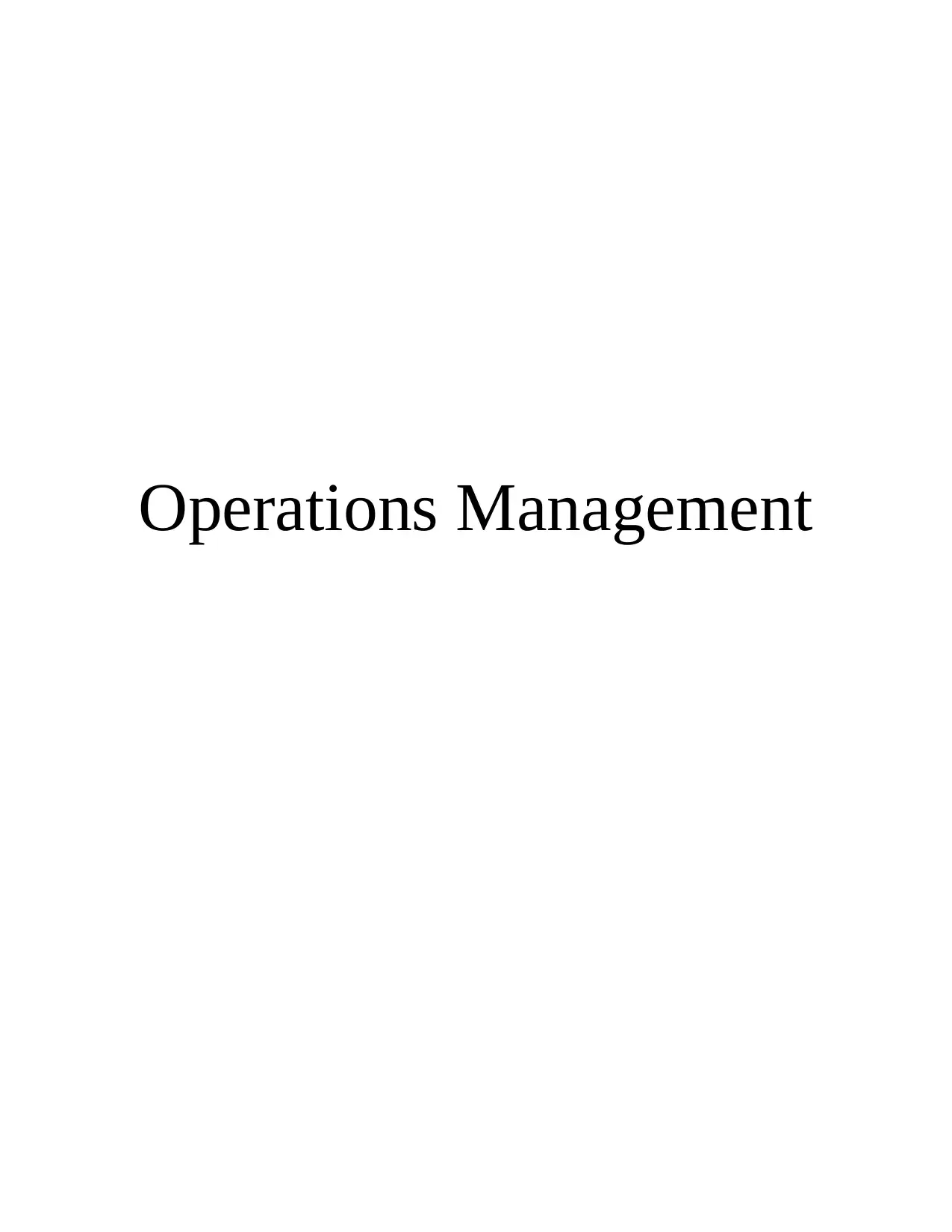
Operations Management
Paraphrase This Document
Need a fresh take? Get an instant paraphrase of this document with our AI Paraphraser
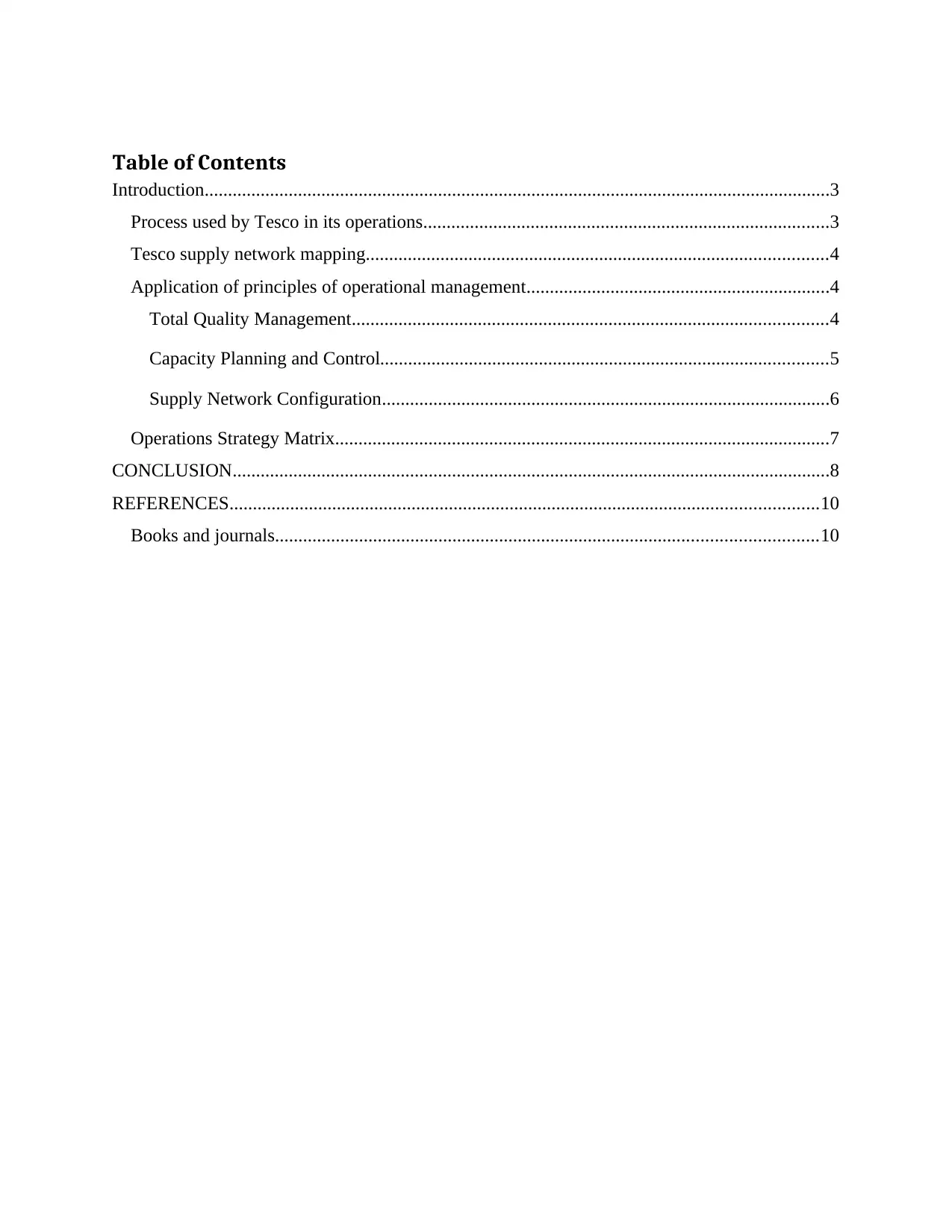
Table of Contents
Introduction......................................................................................................................................3
Process used by Tesco in its operations.......................................................................................3
Tesco supply network mapping...................................................................................................4
Application of principles of operational management.................................................................4
Total Quality Management......................................................................................................4
Capacity Planning and Control................................................................................................5
Supply Network Configuration................................................................................................6
Operations Strategy Matrix..........................................................................................................7
CONCLUSION................................................................................................................................8
REFERENCES..............................................................................................................................10
Books and journals....................................................................................................................10
Introduction......................................................................................................................................3
Process used by Tesco in its operations.......................................................................................3
Tesco supply network mapping...................................................................................................4
Application of principles of operational management.................................................................4
Total Quality Management......................................................................................................4
Capacity Planning and Control................................................................................................5
Supply Network Configuration................................................................................................6
Operations Strategy Matrix..........................................................................................................7
CONCLUSION................................................................................................................................8
REFERENCES..............................................................................................................................10
Books and journals....................................................................................................................10
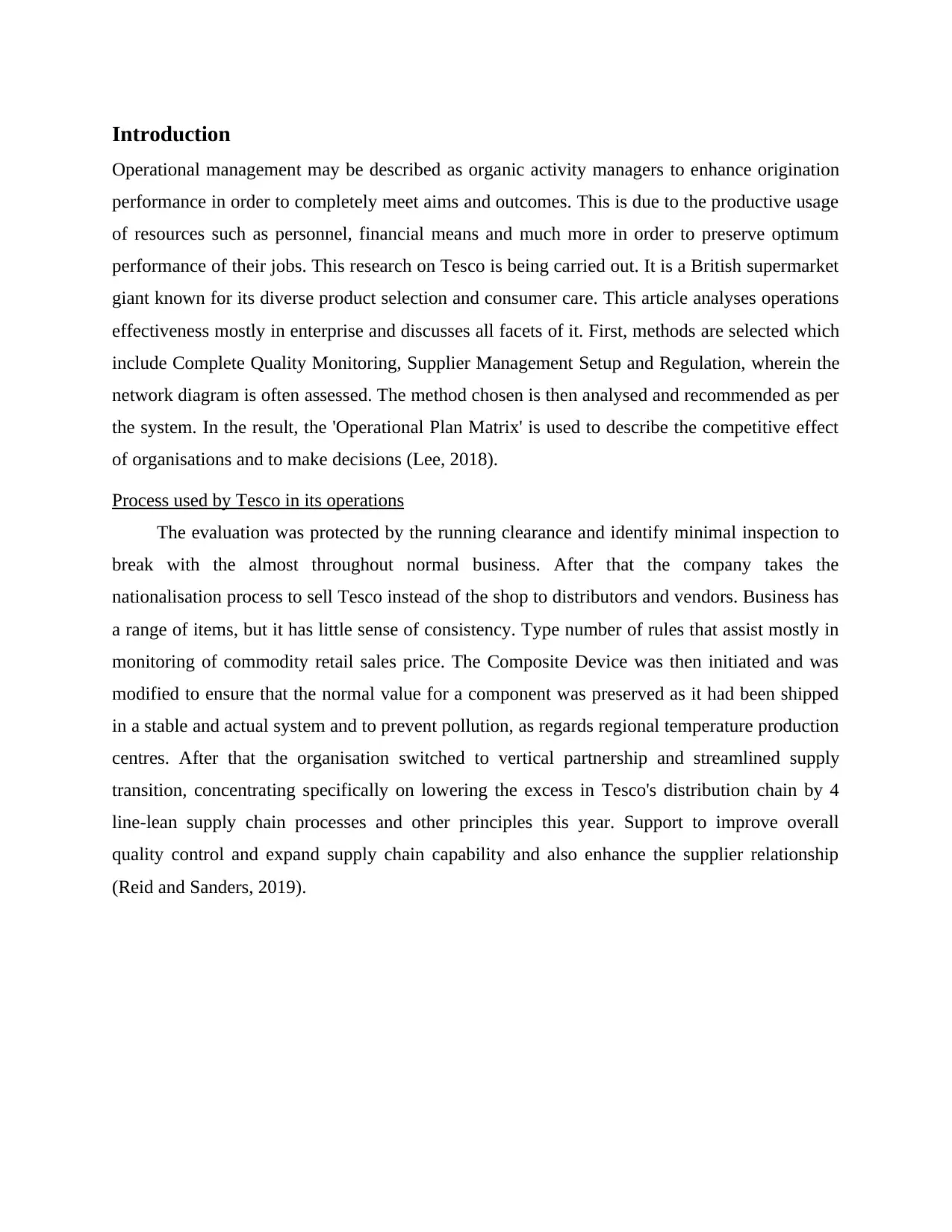
Introduction
Operational management may be described as organic activity managers to enhance origination
performance in order to completely meet aims and outcomes. This is due to the productive usage
of resources such as personnel, financial means and much more in order to preserve optimum
performance of their jobs. This research on Tesco is being carried out. It is a British supermarket
giant known for its diverse product selection and consumer care. This article analyses operations
effectiveness mostly in enterprise and discusses all facets of it. First, methods are selected which
include Complete Quality Monitoring, Supplier Management Setup and Regulation, wherein the
network diagram is often assessed. The method chosen is then analysed and recommended as per
the system. In the result, the 'Operational Plan Matrix' is used to describe the competitive effect
of organisations and to make decisions (Lee, 2018).
Process used by Tesco in its operations
The evaluation was protected by the running clearance and identify minimal inspection to
break with the almost throughout normal business. After that the company takes the
nationalisation process to sell Tesco instead of the shop to distributors and vendors. Business has
a range of items, but it has little sense of consistency. Type number of rules that assist mostly in
monitoring of commodity retail sales price. The Composite Device was then initiated and was
modified to ensure that the normal value for a component was preserved as it had been shipped
in a stable and actual system and to prevent pollution, as regards regional temperature production
centres. After that the organisation switched to vertical partnership and streamlined supply
transition, concentrating specifically on lowering the excess in Tesco's distribution chain by 4
line-lean supply chain processes and other principles this year. Support to improve overall
quality control and expand supply chain capability and also enhance the supplier relationship
(Reid and Sanders, 2019).
Operational management may be described as organic activity managers to enhance origination
performance in order to completely meet aims and outcomes. This is due to the productive usage
of resources such as personnel, financial means and much more in order to preserve optimum
performance of their jobs. This research on Tesco is being carried out. It is a British supermarket
giant known for its diverse product selection and consumer care. This article analyses operations
effectiveness mostly in enterprise and discusses all facets of it. First, methods are selected which
include Complete Quality Monitoring, Supplier Management Setup and Regulation, wherein the
network diagram is often assessed. The method chosen is then analysed and recommended as per
the system. In the result, the 'Operational Plan Matrix' is used to describe the competitive effect
of organisations and to make decisions (Lee, 2018).
Process used by Tesco in its operations
The evaluation was protected by the running clearance and identify minimal inspection to
break with the almost throughout normal business. After that the company takes the
nationalisation process to sell Tesco instead of the shop to distributors and vendors. Business has
a range of items, but it has little sense of consistency. Type number of rules that assist mostly in
monitoring of commodity retail sales price. The Composite Device was then initiated and was
modified to ensure that the normal value for a component was preserved as it had been shipped
in a stable and actual system and to prevent pollution, as regards regional temperature production
centres. After that the organisation switched to vertical partnership and streamlined supply
transition, concentrating specifically on lowering the excess in Tesco's distribution chain by 4
line-lean supply chain processes and other principles this year. Support to improve overall
quality control and expand supply chain capability and also enhance the supplier relationship
(Reid and Sanders, 2019).
⊘ This is a preview!⊘
Do you want full access?
Subscribe today to unlock all pages.

Trusted by 1+ million students worldwide
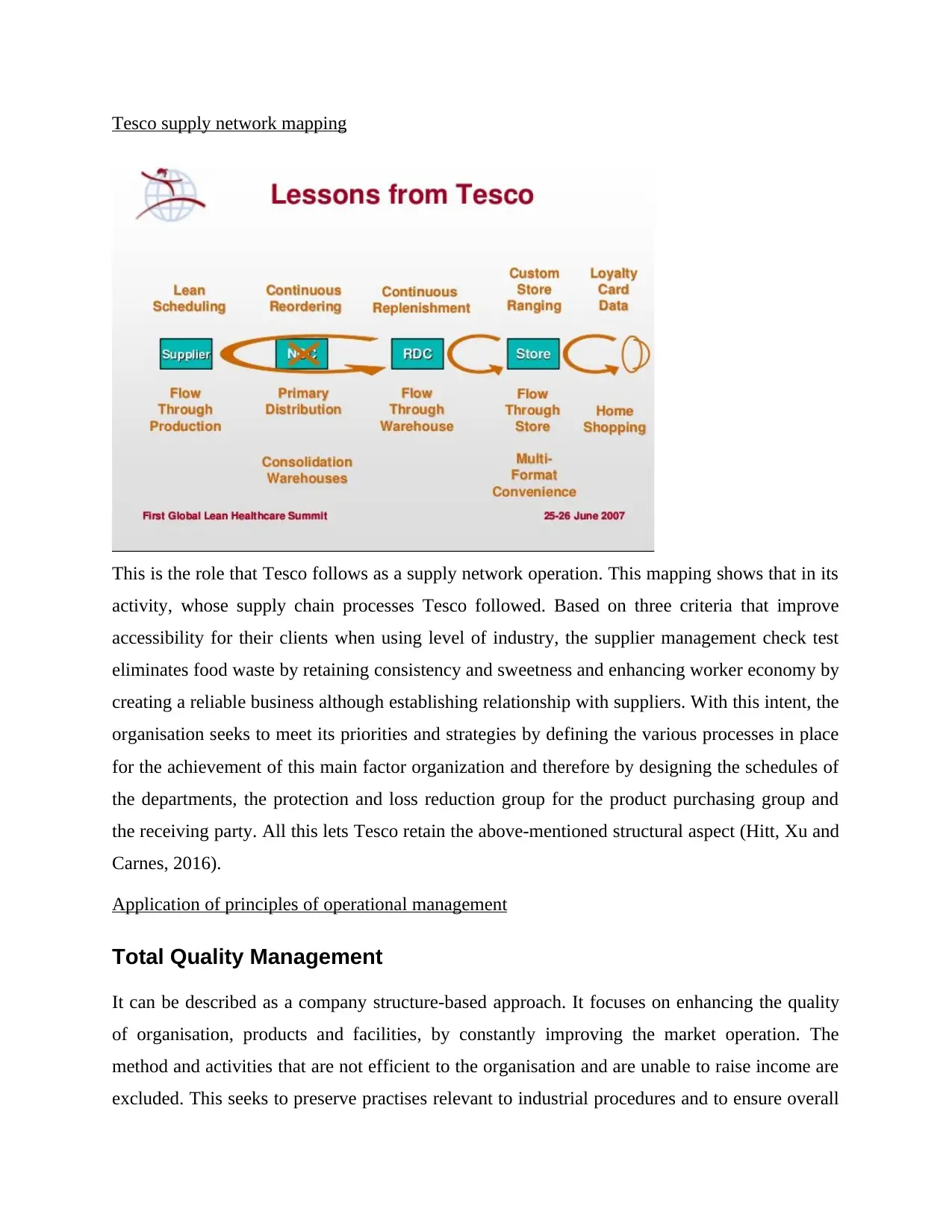
Tesco supply network mapping
This is the role that Tesco follows as a supply network operation. This mapping shows that in its
activity, whose supply chain processes Tesco followed. Based on three criteria that improve
accessibility for their clients when using level of industry, the supplier management check test
eliminates food waste by retaining consistency and sweetness and enhancing worker economy by
creating a reliable business although establishing relationship with suppliers. With this intent, the
organisation seeks to meet its priorities and strategies by defining the various processes in place
for the achievement of this main factor organization and therefore by designing the schedules of
the departments, the protection and loss reduction group for the product purchasing group and
the receiving party. All this lets Tesco retain the above-mentioned structural aspect (Hitt, Xu and
Carnes, 2016).
Application of principles of operational management
Total Quality Management
It can be described as a company structure-based approach. It focuses on enhancing the quality
of organisation, products and facilities, by constantly improving the market operation. The
method and activities that are not efficient to the organisation and are unable to raise income are
excluded. This seeks to preserve practises relevant to industrial procedures and to ensure overall
This is the role that Tesco follows as a supply network operation. This mapping shows that in its
activity, whose supply chain processes Tesco followed. Based on three criteria that improve
accessibility for their clients when using level of industry, the supplier management check test
eliminates food waste by retaining consistency and sweetness and enhancing worker economy by
creating a reliable business although establishing relationship with suppliers. With this intent, the
organisation seeks to meet its priorities and strategies by defining the various processes in place
for the achievement of this main factor organization and therefore by designing the schedules of
the departments, the protection and loss reduction group for the product purchasing group and
the receiving party. All this lets Tesco retain the above-mentioned structural aspect (Hitt, Xu and
Carnes, 2016).
Application of principles of operational management
Total Quality Management
It can be described as a company structure-based approach. It focuses on enhancing the quality
of organisation, products and facilities, by constantly improving the market operation. The
method and activities that are not efficient to the organisation and are unable to raise income are
excluded. This seeks to preserve practises relevant to industrial procedures and to ensure overall
Paraphrase This Document
Need a fresh take? Get an instant paraphrase of this document with our AI Paraphraser
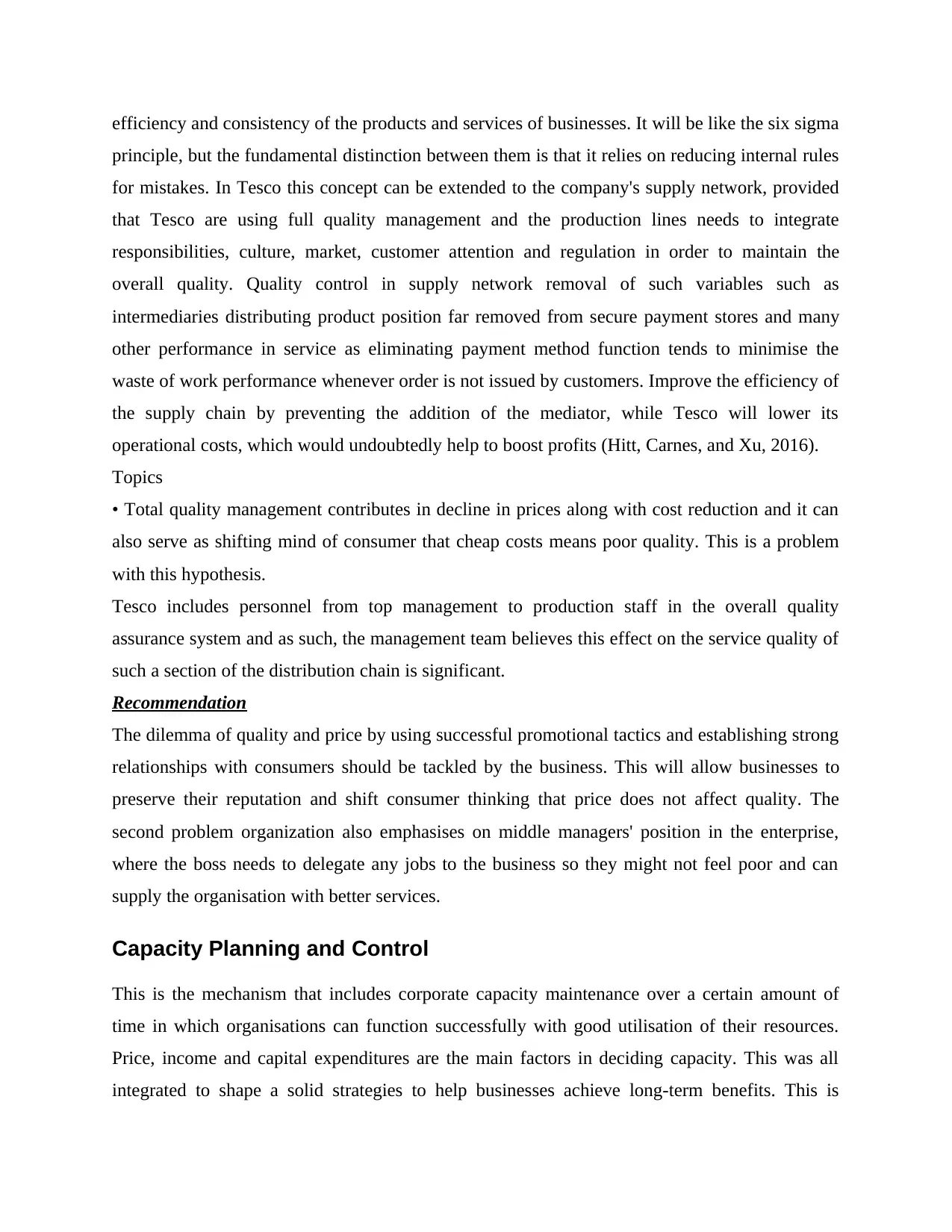
efficiency and consistency of the products and services of businesses. It will be like the six sigma
principle, but the fundamental distinction between them is that it relies on reducing internal rules
for mistakes. In Tesco this concept can be extended to the company's supply network, provided
that Tesco are using full quality management and the production lines needs to integrate
responsibilities, culture, market, customer attention and regulation in order to maintain the
overall quality. Quality control in supply network removal of such variables such as
intermediaries distributing product position far removed from secure payment stores and many
other performance in service as eliminating payment method function tends to minimise the
waste of work performance whenever order is not issued by customers. Improve the efficiency of
the supply chain by preventing the addition of the mediator, while Tesco will lower its
operational costs, which would undoubtedly help to boost profits (Hitt, Carnes, and Xu, 2016).
Topics
• Total quality management contributes in decline in prices along with cost reduction and it can
also serve as shifting mind of consumer that cheap costs means poor quality. This is a problem
with this hypothesis.
Tesco includes personnel from top management to production staff in the overall quality
assurance system and as such, the management team believes this effect on the service quality of
such a section of the distribution chain is significant.
Recommendation
The dilemma of quality and price by using successful promotional tactics and establishing strong
relationships with consumers should be tackled by the business. This will allow businesses to
preserve their reputation and shift consumer thinking that price does not affect quality. The
second problem organization also emphasises on middle managers' position in the enterprise,
where the boss needs to delegate any jobs to the business so they might not feel poor and can
supply the organisation with better services.
Capacity Planning and Control
This is the mechanism that includes corporate capacity maintenance over a certain amount of
time in which organisations can function successfully with good utilisation of their resources.
Price, income and capital expenditures are the main factors in deciding capacity. This was all
integrated to shape a solid strategies to help businesses achieve long-term benefits. This is
principle, but the fundamental distinction between them is that it relies on reducing internal rules
for mistakes. In Tesco this concept can be extended to the company's supply network, provided
that Tesco are using full quality management and the production lines needs to integrate
responsibilities, culture, market, customer attention and regulation in order to maintain the
overall quality. Quality control in supply network removal of such variables such as
intermediaries distributing product position far removed from secure payment stores and many
other performance in service as eliminating payment method function tends to minimise the
waste of work performance whenever order is not issued by customers. Improve the efficiency of
the supply chain by preventing the addition of the mediator, while Tesco will lower its
operational costs, which would undoubtedly help to boost profits (Hitt, Carnes, and Xu, 2016).
Topics
• Total quality management contributes in decline in prices along with cost reduction and it can
also serve as shifting mind of consumer that cheap costs means poor quality. This is a problem
with this hypothesis.
Tesco includes personnel from top management to production staff in the overall quality
assurance system and as such, the management team believes this effect on the service quality of
such a section of the distribution chain is significant.
Recommendation
The dilemma of quality and price by using successful promotional tactics and establishing strong
relationships with consumers should be tackled by the business. This will allow businesses to
preserve their reputation and shift consumer thinking that price does not affect quality. The
second problem organization also emphasises on middle managers' position in the enterprise,
where the boss needs to delegate any jobs to the business so they might not feel poor and can
supply the organisation with better services.
Capacity Planning and Control
This is the mechanism that includes corporate capacity maintenance over a certain amount of
time in which organisations can function successfully with good utilisation of their resources.
Price, income and capital expenditures are the main factors in deciding capacity. This was all
integrated to shape a solid strategies to help businesses achieve long-term benefits. This is
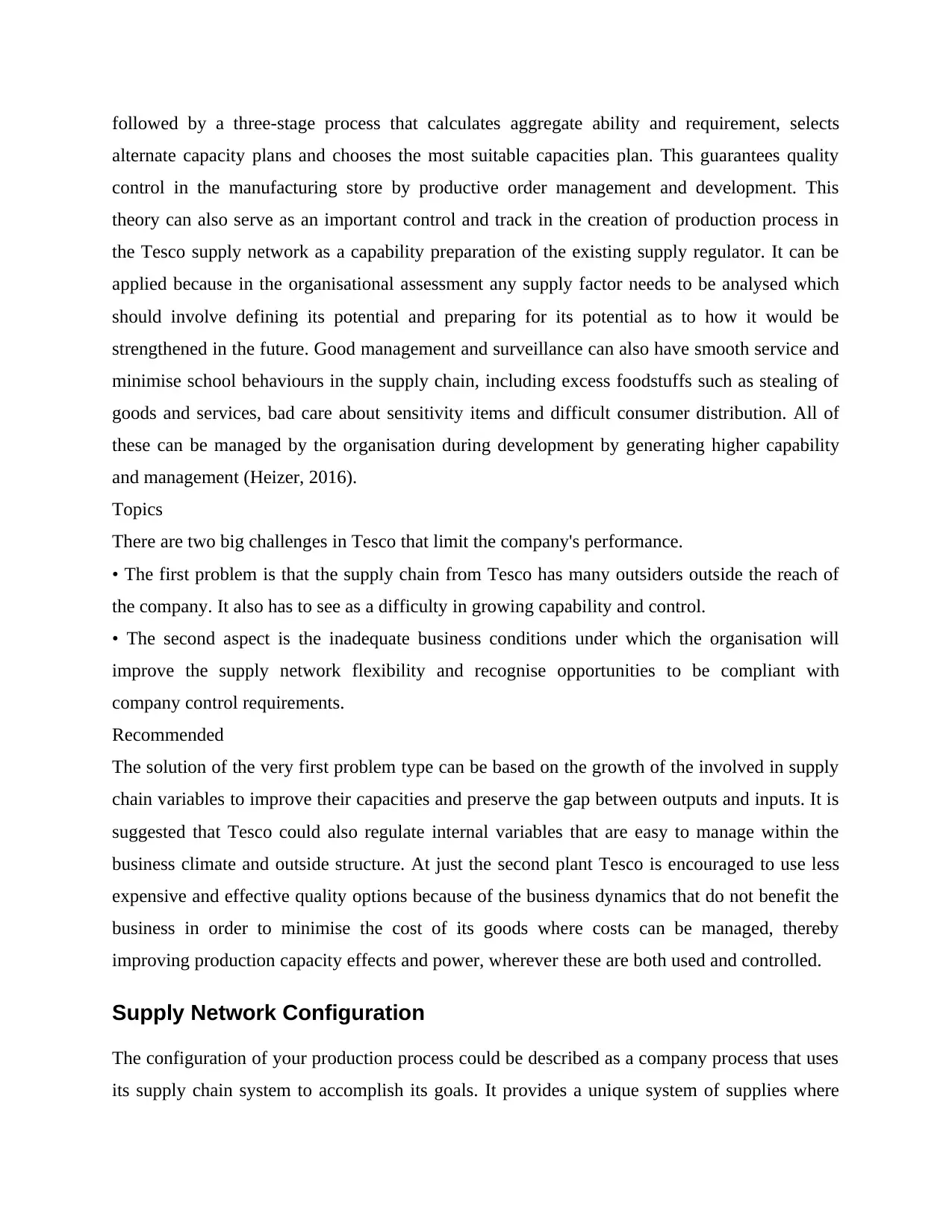
followed by a three-stage process that calculates aggregate ability and requirement, selects
alternate capacity plans and chooses the most suitable capacities plan. This guarantees quality
control in the manufacturing store by productive order management and development. This
theory can also serve as an important control and track in the creation of production process in
the Tesco supply network as a capability preparation of the existing supply regulator. It can be
applied because in the organisational assessment any supply factor needs to be analysed which
should involve defining its potential and preparing for its potential as to how it would be
strengthened in the future. Good management and surveillance can also have smooth service and
minimise school behaviours in the supply chain, including excess foodstuffs such as stealing of
goods and services, bad care about sensitivity items and difficult consumer distribution. All of
these can be managed by the organisation during development by generating higher capability
and management (Heizer, 2016).
Topics
There are two big challenges in Tesco that limit the company's performance.
• The first problem is that the supply chain from Tesco has many outsiders outside the reach of
the company. It also has to see as a difficulty in growing capability and control.
• The second aspect is the inadequate business conditions under which the organisation will
improve the supply network flexibility and recognise opportunities to be compliant with
company control requirements.
Recommended
The solution of the very first problem type can be based on the growth of the involved in supply
chain variables to improve their capacities and preserve the gap between outputs and inputs. It is
suggested that Tesco could also regulate internal variables that are easy to manage within the
business climate and outside structure. At just the second plant Tesco is encouraged to use less
expensive and effective quality options because of the business dynamics that do not benefit the
business in order to minimise the cost of its goods where costs can be managed, thereby
improving production capacity effects and power, wherever these are both used and controlled.
Supply Network Configuration
The configuration of your production process could be described as a company process that uses
its supply chain system to accomplish its goals. It provides a unique system of supplies where
alternate capacity plans and chooses the most suitable capacities plan. This guarantees quality
control in the manufacturing store by productive order management and development. This
theory can also serve as an important control and track in the creation of production process in
the Tesco supply network as a capability preparation of the existing supply regulator. It can be
applied because in the organisational assessment any supply factor needs to be analysed which
should involve defining its potential and preparing for its potential as to how it would be
strengthened in the future. Good management and surveillance can also have smooth service and
minimise school behaviours in the supply chain, including excess foodstuffs such as stealing of
goods and services, bad care about sensitivity items and difficult consumer distribution. All of
these can be managed by the organisation during development by generating higher capability
and management (Heizer, 2016).
Topics
There are two big challenges in Tesco that limit the company's performance.
• The first problem is that the supply chain from Tesco has many outsiders outside the reach of
the company. It also has to see as a difficulty in growing capability and control.
• The second aspect is the inadequate business conditions under which the organisation will
improve the supply network flexibility and recognise opportunities to be compliant with
company control requirements.
Recommended
The solution of the very first problem type can be based on the growth of the involved in supply
chain variables to improve their capacities and preserve the gap between outputs and inputs. It is
suggested that Tesco could also regulate internal variables that are easy to manage within the
business climate and outside structure. At just the second plant Tesco is encouraged to use less
expensive and effective quality options because of the business dynamics that do not benefit the
business in order to minimise the cost of its goods where costs can be managed, thereby
improving production capacity effects and power, wherever these are both used and controlled.
Supply Network Configuration
The configuration of your production process could be described as a company process that uses
its supply chain system to accomplish its goals. It provides a unique system of supplies where
⊘ This is a preview!⊘
Do you want full access?
Subscribe today to unlock all pages.

Trusted by 1+ million students worldwide
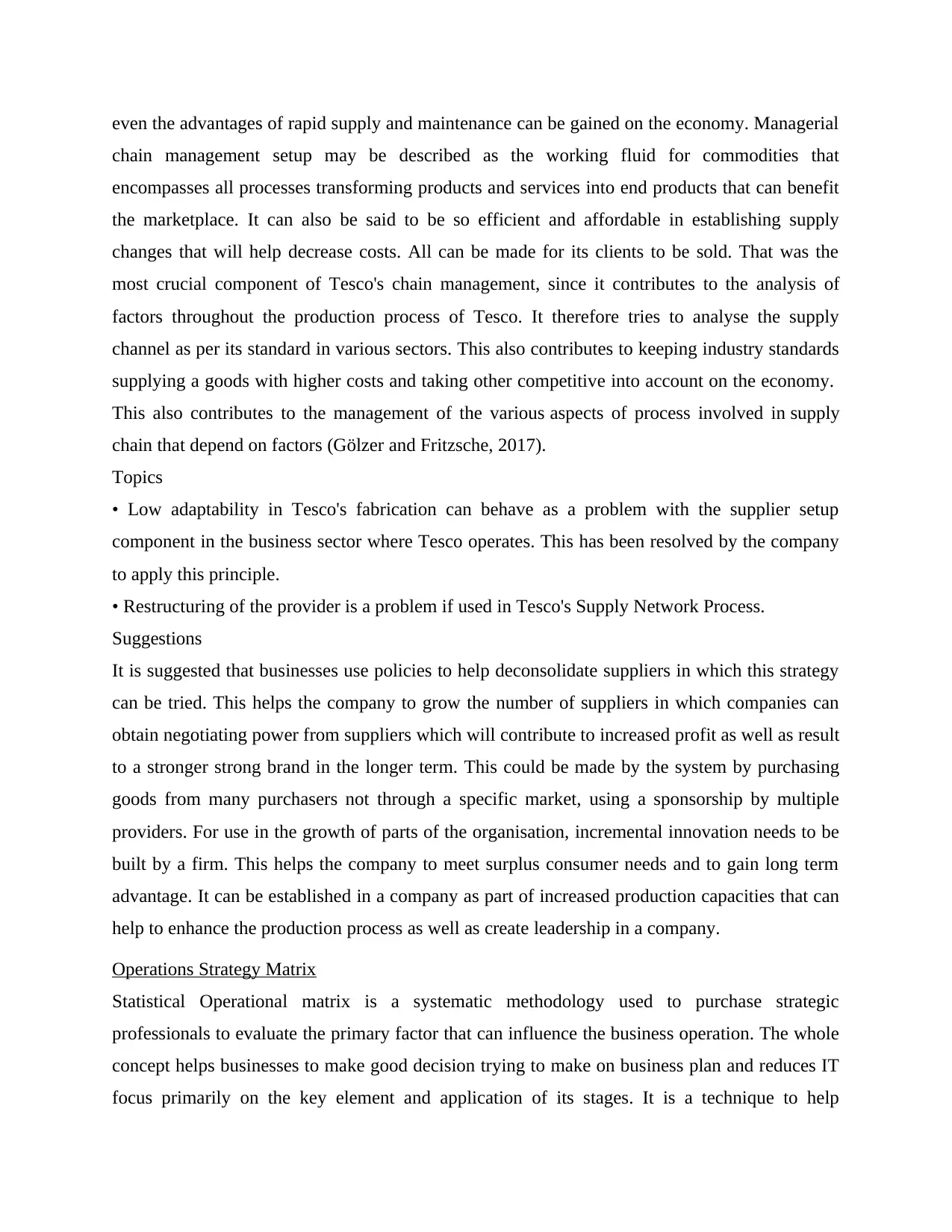
even the advantages of rapid supply and maintenance can be gained on the economy. Managerial
chain management setup may be described as the working fluid for commodities that
encompasses all processes transforming products and services into end products that can benefit
the marketplace. It can also be said to be so efficient and affordable in establishing supply
changes that will help decrease costs. All can be made for its clients to be sold. That was the
most crucial component of Tesco's chain management, since it contributes to the analysis of
factors throughout the production process of Tesco. It therefore tries to analyse the supply
channel as per its standard in various sectors. This also contributes to keeping industry standards
supplying a goods with higher costs and taking other competitive into account on the economy.
This also contributes to the management of the various aspects of process involved in supply
chain that depend on factors (Gölzer and Fritzsche, 2017).
Topics
• Low adaptability in Tesco's fabrication can behave as a problem with the supplier setup
component in the business sector where Tesco operates. This has been resolved by the company
to apply this principle.
• Restructuring of the provider is a problem if used in Tesco's Supply Network Process.
Suggestions
It is suggested that businesses use policies to help deconsolidate suppliers in which this strategy
can be tried. This helps the company to grow the number of suppliers in which companies can
obtain negotiating power from suppliers which will contribute to increased profit as well as result
to a stronger strong brand in the longer term. This could be made by the system by purchasing
goods from many purchasers not through a specific market, using a sponsorship by multiple
providers. For use in the growth of parts of the organisation, incremental innovation needs to be
built by a firm. This helps the company to meet surplus consumer needs and to gain long term
advantage. It can be established in a company as part of increased production capacities that can
help to enhance the production process as well as create leadership in a company.
Operations Strategy Matrix
Statistical Operational matrix is a systematic methodology used to purchase strategic
professionals to evaluate the primary factor that can influence the business operation. The whole
concept helps businesses to make good decision trying to make on business plan and reduces IT
focus primarily on the key element and application of its stages. It is a technique to help
chain management setup may be described as the working fluid for commodities that
encompasses all processes transforming products and services into end products that can benefit
the marketplace. It can also be said to be so efficient and affordable in establishing supply
changes that will help decrease costs. All can be made for its clients to be sold. That was the
most crucial component of Tesco's chain management, since it contributes to the analysis of
factors throughout the production process of Tesco. It therefore tries to analyse the supply
channel as per its standard in various sectors. This also contributes to keeping industry standards
supplying a goods with higher costs and taking other competitive into account on the economy.
This also contributes to the management of the various aspects of process involved in supply
chain that depend on factors (Gölzer and Fritzsche, 2017).
Topics
• Low adaptability in Tesco's fabrication can behave as a problem with the supplier setup
component in the business sector where Tesco operates. This has been resolved by the company
to apply this principle.
• Restructuring of the provider is a problem if used in Tesco's Supply Network Process.
Suggestions
It is suggested that businesses use policies to help deconsolidate suppliers in which this strategy
can be tried. This helps the company to grow the number of suppliers in which companies can
obtain negotiating power from suppliers which will contribute to increased profit as well as result
to a stronger strong brand in the longer term. This could be made by the system by purchasing
goods from many purchasers not through a specific market, using a sponsorship by multiple
providers. For use in the growth of parts of the organisation, incremental innovation needs to be
built by a firm. This helps the company to meet surplus consumer needs and to gain long term
advantage. It can be established in a company as part of increased production capacities that can
help to enhance the production process as well as create leadership in a company.
Operations Strategy Matrix
Statistical Operational matrix is a systematic methodology used to purchase strategic
professionals to evaluate the primary factor that can influence the business operation. The whole
concept helps businesses to make good decision trying to make on business plan and reduces IT
focus primarily on the key element and application of its stages. It is a technique to help
Paraphrase This Document
Need a fresh take? Get an instant paraphrase of this document with our AI Paraphraser
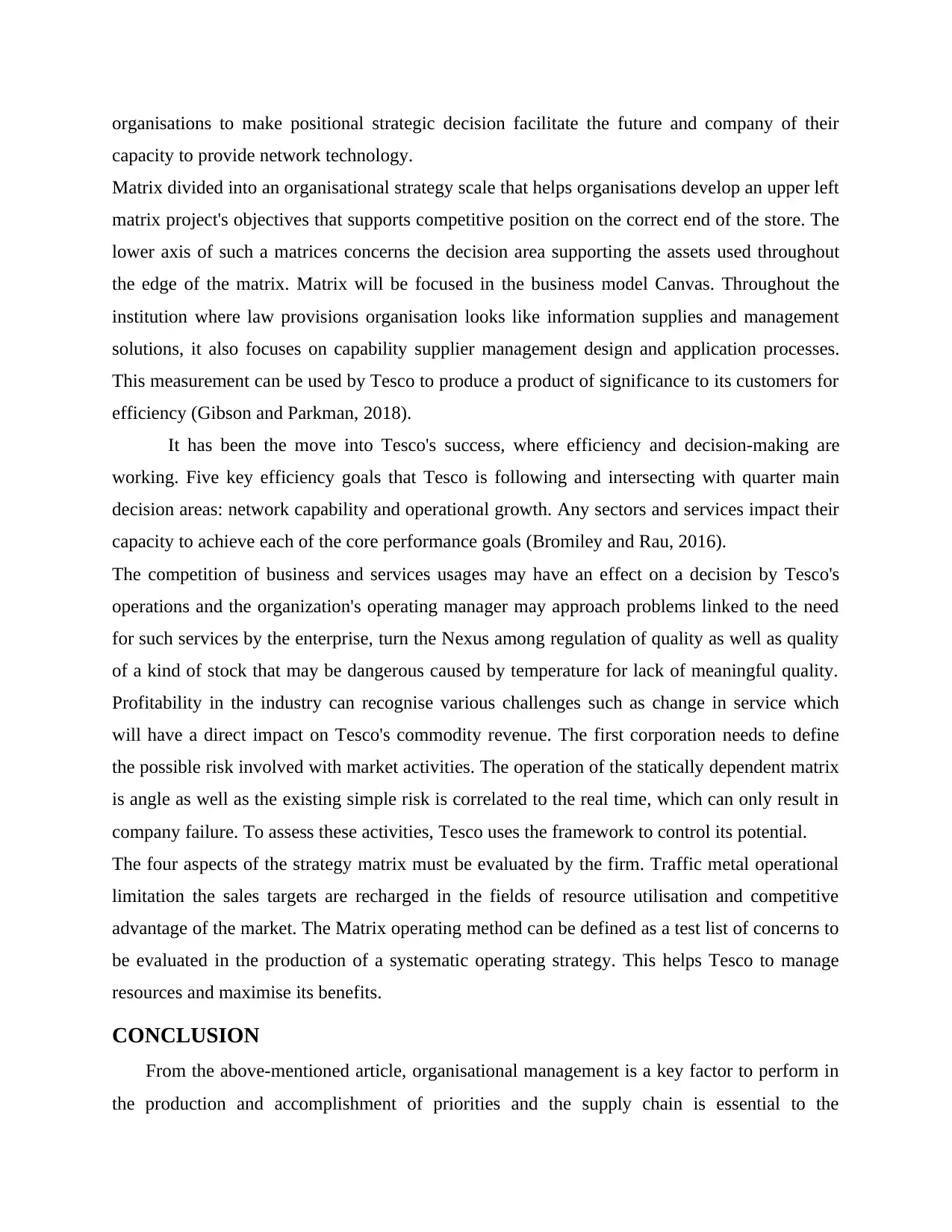
organisations to make positional strategic decision facilitate the future and company of their
capacity to provide network technology.
Matrix divided into an organisational strategy scale that helps organisations develop an upper left
matrix project's objectives that supports competitive position on the correct end of the store. The
lower axis of such a matrices concerns the decision area supporting the assets used throughout
the edge of the matrix. Matrix will be focused in the business model Canvas. Throughout the
institution where law provisions organisation looks like information supplies and management
solutions, it also focuses on capability supplier management design and application processes.
This measurement can be used by Tesco to produce a product of significance to its customers for
efficiency (Gibson and Parkman, 2018).
It has been the move into Tesco's success, where efficiency and decision-making are
working. Five key efficiency goals that Tesco is following and intersecting with quarter main
decision areas: network capability and operational growth. Any sectors and services impact their
capacity to achieve each of the core performance goals (Bromiley and Rau, 2016).
The competition of business and services usages may have an effect on a decision by Tesco's
operations and the organization's operating manager may approach problems linked to the need
for such services by the enterprise, turn the Nexus among regulation of quality as well as quality
of a kind of stock that may be dangerous caused by temperature for lack of meaningful quality.
Profitability in the industry can recognise various challenges such as change in service which
will have a direct impact on Tesco's commodity revenue. The first corporation needs to define
the possible risk involved with market activities. The operation of the statically dependent matrix
is angle as well as the existing simple risk is correlated to the real time, which can only result in
company failure. To assess these activities, Tesco uses the framework to control its potential.
The four aspects of the strategy matrix must be evaluated by the firm. Traffic metal operational
limitation the sales targets are recharged in the fields of resource utilisation and competitive
advantage of the market. The Matrix operating method can be defined as a test list of concerns to
be evaluated in the production of a systematic operating strategy. This helps Tesco to manage
resources and maximise its benefits.
CONCLUSION
From the above-mentioned article, organisational management is a key factor to perform in
the production and accomplishment of priorities and the supply chain is essential to the
capacity to provide network technology.
Matrix divided into an organisational strategy scale that helps organisations develop an upper left
matrix project's objectives that supports competitive position on the correct end of the store. The
lower axis of such a matrices concerns the decision area supporting the assets used throughout
the edge of the matrix. Matrix will be focused in the business model Canvas. Throughout the
institution where law provisions organisation looks like information supplies and management
solutions, it also focuses on capability supplier management design and application processes.
This measurement can be used by Tesco to produce a product of significance to its customers for
efficiency (Gibson and Parkman, 2018).
It has been the move into Tesco's success, where efficiency and decision-making are
working. Five key efficiency goals that Tesco is following and intersecting with quarter main
decision areas: network capability and operational growth. Any sectors and services impact their
capacity to achieve each of the core performance goals (Bromiley and Rau, 2016).
The competition of business and services usages may have an effect on a decision by Tesco's
operations and the organization's operating manager may approach problems linked to the need
for such services by the enterprise, turn the Nexus among regulation of quality as well as quality
of a kind of stock that may be dangerous caused by temperature for lack of meaningful quality.
Profitability in the industry can recognise various challenges such as change in service which
will have a direct impact on Tesco's commodity revenue. The first corporation needs to define
the possible risk involved with market activities. The operation of the statically dependent matrix
is angle as well as the existing simple risk is correlated to the real time, which can only result in
company failure. To assess these activities, Tesco uses the framework to control its potential.
The four aspects of the strategy matrix must be evaluated by the firm. Traffic metal operational
limitation the sales targets are recharged in the fields of resource utilisation and competitive
advantage of the market. The Matrix operating method can be defined as a test list of concerns to
be evaluated in the production of a systematic operating strategy. This helps Tesco to manage
resources and maximise its benefits.
CONCLUSION
From the above-mentioned article, organisational management is a key factor to perform in
the production and accomplishment of priorities and the supply chain is essential to the
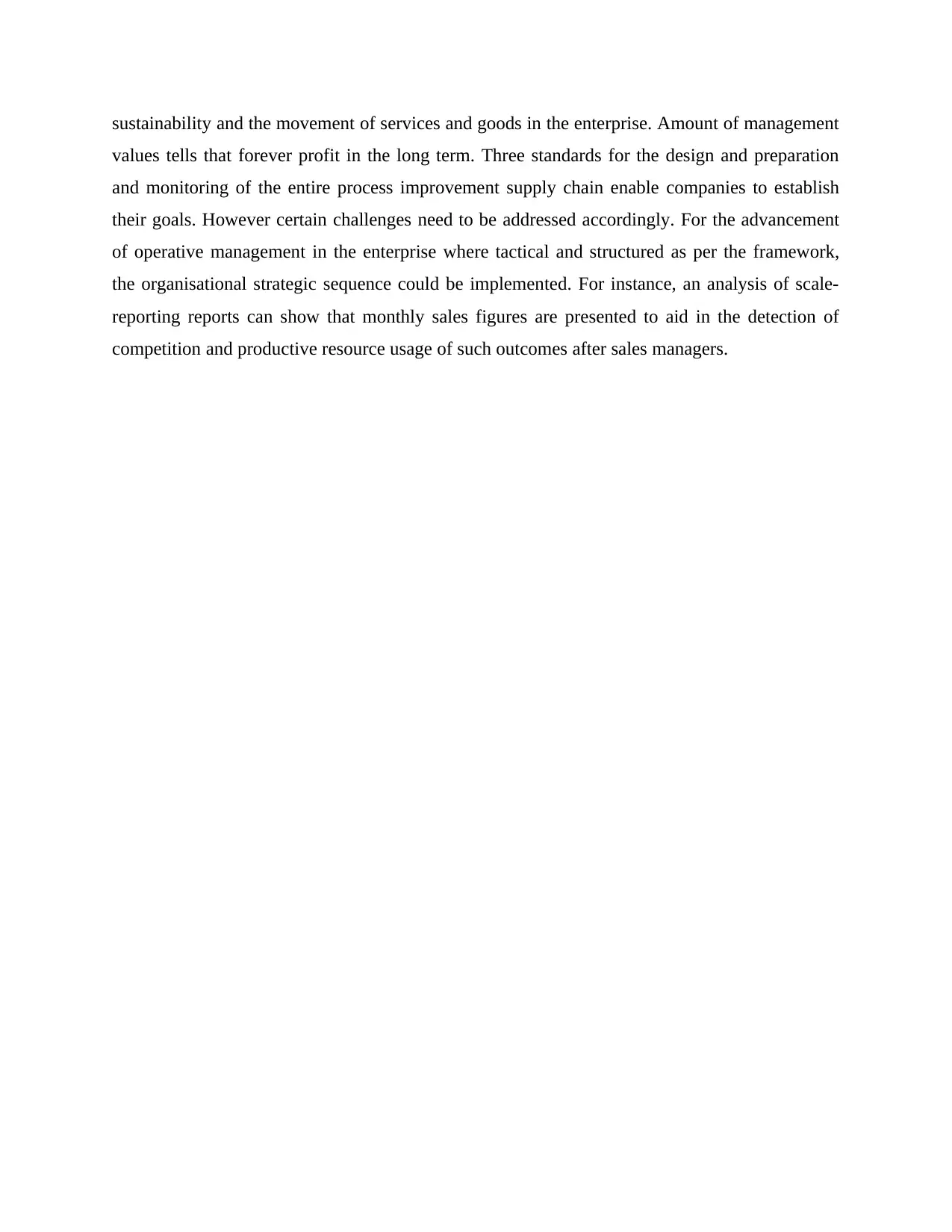
sustainability and the movement of services and goods in the enterprise. Amount of management
values tells that forever profit in the long term. Three standards for the design and preparation
and monitoring of the entire process improvement supply chain enable companies to establish
their goals. However certain challenges need to be addressed accordingly. For the advancement
of operative management in the enterprise where tactical and structured as per the framework,
the organisational strategic sequence could be implemented. For instance, an analysis of scale-
reporting reports can show that monthly sales figures are presented to aid in the detection of
competition and productive resource usage of such outcomes after sales managers.
values tells that forever profit in the long term. Three standards for the design and preparation
and monitoring of the entire process improvement supply chain enable companies to establish
their goals. However certain challenges need to be addressed accordingly. For the advancement
of operative management in the enterprise where tactical and structured as per the framework,
the organisational strategic sequence could be implemented. For instance, an analysis of scale-
reporting reports can show that monthly sales figures are presented to aid in the detection of
competition and productive resource usage of such outcomes after sales managers.
⊘ This is a preview!⊘
Do you want full access?
Subscribe today to unlock all pages.

Trusted by 1+ million students worldwide
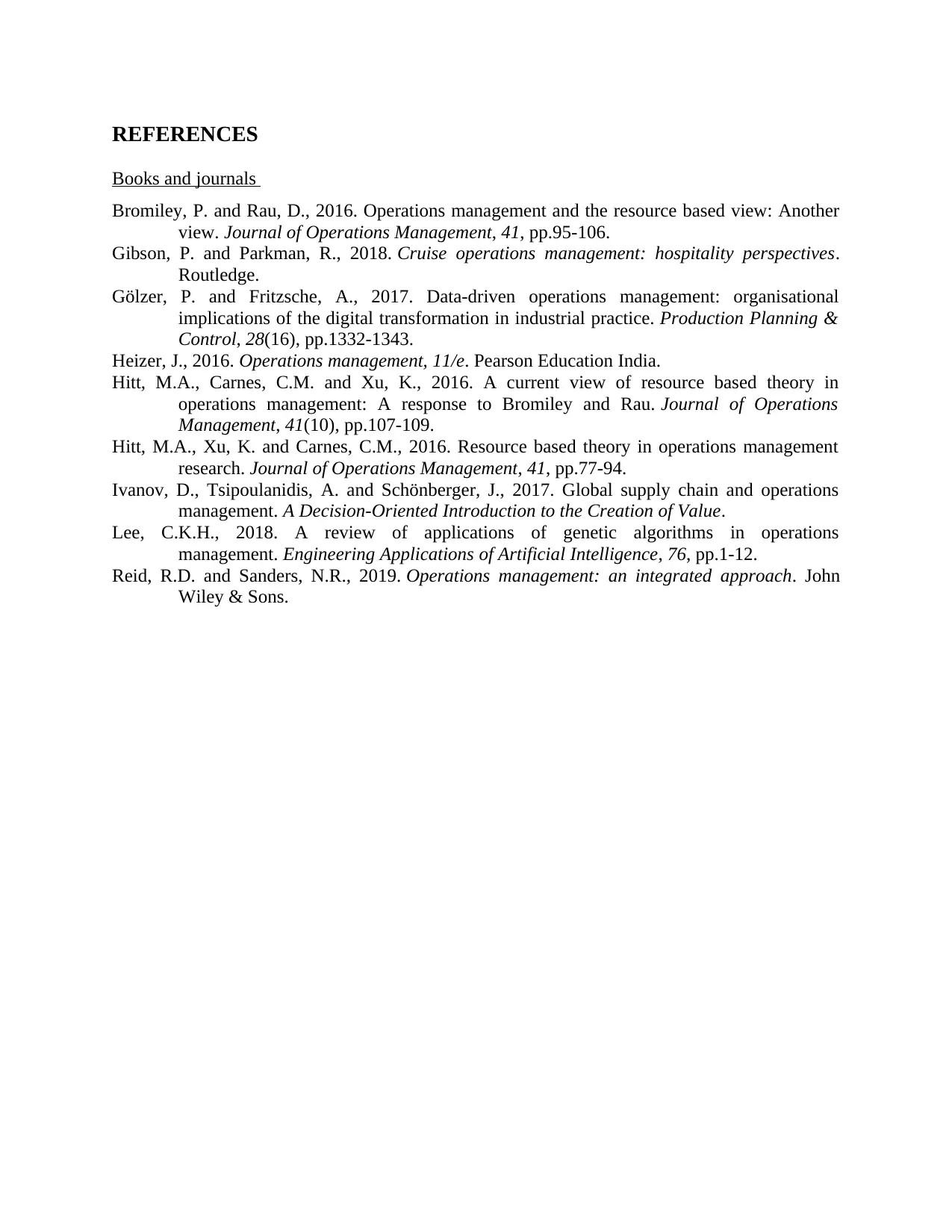
REFERENCES
Books and journals
Bromiley, P. and Rau, D., 2016. Operations management and the resource based view: Another
view. Journal of Operations Management, 41, pp.95-106.
Gibson, P. and Parkman, R., 2018. Cruise operations management: hospitality perspectives.
Routledge.
Gölzer, P. and Fritzsche, A., 2017. Data-driven operations management: organisational
implications of the digital transformation in industrial practice. Production Planning &
Control, 28(16), pp.1332-1343.
Heizer, J., 2016. Operations management, 11/e. Pearson Education India.
Hitt, M.A., Carnes, C.M. and Xu, K., 2016. A current view of resource based theory in
operations management: A response to Bromiley and Rau. Journal of Operations
Management, 41(10), pp.107-109.
Hitt, M.A., Xu, K. and Carnes, C.M., 2016. Resource based theory in operations management
research. Journal of Operations Management, 41, pp.77-94.
Ivanov, D., Tsipoulanidis, A. and Schönberger, J., 2017. Global supply chain and operations
management. A Decision-Oriented Introduction to the Creation of Value.
Lee, C.K.H., 2018. A review of applications of genetic algorithms in operations
management. Engineering Applications of Artificial Intelligence, 76, pp.1-12.
Reid, R.D. and Sanders, N.R., 2019. Operations management: an integrated approach. John
Wiley & Sons.
Books and journals
Bromiley, P. and Rau, D., 2016. Operations management and the resource based view: Another
view. Journal of Operations Management, 41, pp.95-106.
Gibson, P. and Parkman, R., 2018. Cruise operations management: hospitality perspectives.
Routledge.
Gölzer, P. and Fritzsche, A., 2017. Data-driven operations management: organisational
implications of the digital transformation in industrial practice. Production Planning &
Control, 28(16), pp.1332-1343.
Heizer, J., 2016. Operations management, 11/e. Pearson Education India.
Hitt, M.A., Carnes, C.M. and Xu, K., 2016. A current view of resource based theory in
operations management: A response to Bromiley and Rau. Journal of Operations
Management, 41(10), pp.107-109.
Hitt, M.A., Xu, K. and Carnes, C.M., 2016. Resource based theory in operations management
research. Journal of Operations Management, 41, pp.77-94.
Ivanov, D., Tsipoulanidis, A. and Schönberger, J., 2017. Global supply chain and operations
management. A Decision-Oriented Introduction to the Creation of Value.
Lee, C.K.H., 2018. A review of applications of genetic algorithms in operations
management. Engineering Applications of Artificial Intelligence, 76, pp.1-12.
Reid, R.D. and Sanders, N.R., 2019. Operations management: an integrated approach. John
Wiley & Sons.
1 out of 10
Related Documents
Your All-in-One AI-Powered Toolkit for Academic Success.
+13062052269
info@desklib.com
Available 24*7 on WhatsApp / Email
![[object Object]](/_next/static/media/star-bottom.7253800d.svg)
Unlock your academic potential
Copyright © 2020–2025 A2Z Services. All Rights Reserved. Developed and managed by ZUCOL.



